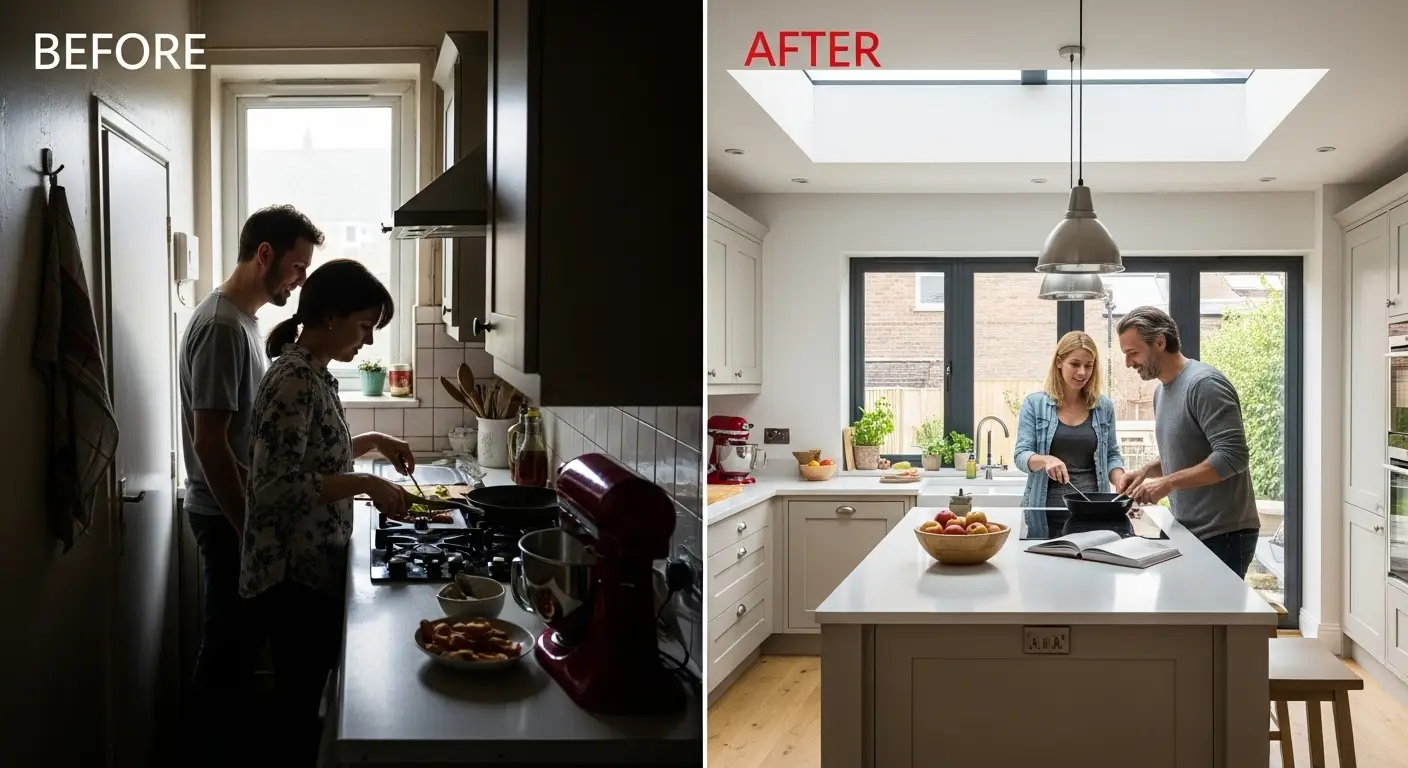Kitchen extensions are transforming homes across the UK, and it is not just about gaining a few extra square metres. A well-designed extension can add up to 15 percent to your home’s value and create a space that feels brighter, bigger, and more inviting. People often focus on the size, expecting dramatic changes only come with large projects. The surprise is that even small kitchen extensions, when designed cleverly, can deliver huge benefits in utility and lifestyle you would not expect from their modest footprint.
Table of Contents
- Understand The Benefits Of A Kitchen Extension
- Assess Your Current Space And Needs
- Explore Design Styles For Your Extension
- Consider Open Layouts For Better Flow
- Maximise Natural Light With Windows And Doors
- Use Smart Storage Solutions For Compact Spaces
- Review Before And After Gallery For Inspiration
Quick Summary
| Takeaway | Explanation |
|---|---|
| Increased Property Value | A kitchen extension can boost your home’s market value by up to 15%. |
| Redesign Your Workflow | Assess your kitchen’s layout to improve efficiency and functionality. |
| Embrace Natural Light | Use large windows and skylights to enhance brightness and mood. |
| Choose Smart Storage Solutions | Incorporate vertical and multifunctional storage to optimise space. |
| Inspire through Before/After Galleries | Review transformations for creative ideas and insights into design possibilities. |
1: Understand the Benefits of a Kitchen Extension
A kitchen extension represents more than just additional square metres in your home; it is a strategic investment that transforms both your living space and property value. When thoughtfully designed, these compact architectural improvements can dramatically enhance functionality, aesthetic appeal, and overall quality of life.
Homeowners considering a kitchen extension should understand the multifaceted advantages of this home improvement strategy. Learn more about kitchen extension benefits to make an informed decision about your property’s potential.
The primary benefits of a small kitchen extension include:
Increased Property Value: A well-executed kitchen extension can potentially add up to 15% to your home’s market value.
Enhanced Living Space: Creating an open, versatile area that seamlessly connects cooking, dining, and social interactions.
Improved Natural Lighting: Strategic design can introduce more natural light, making your kitchen feel larger and more welcoming.
According to research from the Federation of Master Builders, kitchen extensions are among the most cost-effective home improvement projects. They offer exceptional return on investment by combining practical functionality with aesthetic enhancement.
Moreover, a kitchen extension provides an opportunity to reimagine your home’s layout. Modern extensions can integrate energy-efficient technologies, improving your property’s sustainability and potentially reducing long-term utility costs. This means you are not just creating space, but also investing in a more environmentally responsible living environment.
Consider your extension as a chance to redesign workflow, introduce modern appliances, and create a more ergonomic cooking space. The right design can transform a cramped, outdated kitchen into a vibrant, efficient heart of your home.
2: Assess Your Current Space and Needs
Before embarking on a kitchen extension project, conducting a thorough assessment of your current space and specific needs is crucial. This strategic evaluation will help you make informed decisions about design, functionality, and budget.
Understanding Your Current Kitchen Layout
A comprehensive space assessment involves examining how you currently use your kitchen and identifying pain points in its design. Learn more about optimising kitchen spaces to guide your planning process.
Key considerations for assessing your kitchen space include:
Workflow Efficiency: Evaluate current movement patterns and areas of congestion
Storage Requirements: Analyse existing storage solutions and potential improvements
Cooking and Dining Dynamics: Understand how your kitchen supports daily cooking and social interactions
According to research from Public Health England, the relationship between home environment and personal wellbeing is significant. Your kitchen extension should not just be about additional space, but about creating a healthier, more functional living area.
Consider measuring your current kitchen dimensions precisely, documenting natural light sources, and noting electrical and plumbing locations. These details will be critical when discussing potential extension designs with professionals.
Additionally, reflect on your long-term lifestyle needs. Are you planning to expand your family? Do you enjoy entertaining? Will you be working from home more frequently? These questions will help shape an extension that grows with your evolving requirements.
A successful kitchen extension transforms not just physical space, but how you experience and interact with your home environment. By carefully assessing your current needs, you lay the groundwork for a truly personalised and functional design.
3: Explore Design Styles for Your Extension
Choosing the right design style for your kitchen extension is pivotal in creating a space that reflects your personal aesthetic while complementing your existing home architecture. Discover bespoke extension design options to inspire your transformation.
Contemporary Design Trends
Modern kitchen extensions are moving beyond traditional boundaries, embracing innovative approaches that blend functionality with aesthetic appeal. According to research from the Federation of Master Builders, emerging design trends showcase remarkable versatility.
Key design styles to consider include:
Minimalist Urban: Clean lines, neutral colour palettes, integrated appliances
Industrial Chic: Exposed brick, metal accents, open shelving
Natural Harmony: Organic materials, soft earth tones, seamless indoor-outdoor connections
Architectural Integration
A successful kitchen extension should feel like a natural progression of your existing home, not an afterthought. Careful material selection and architectural coherence are crucial. Consider matching external materials like brickwork or rendering to ensure visual continuity.
For smaller spaces, clever design strategies can create an illusion of expansiveness. Large windows, skylights, and sliding glass doors can dramatically transform a compact kitchen extension, flooding the area with natural light and creating a sense of openness.
The strategic use of glass and contemporary glazing allows you to blur boundaries between interior and exterior spaces. Crittal-style doors and floor-to-ceiling windows not only enhance visual appeal but also improve natural ventilation and create a direct connection with your garden or outdoor area.
Remember that your kitchen extension is more than a construction project. It is an opportunity to reimagine how you interact with your living space, creating an environment that supports your lifestyle and reflects your personal design sensibilities.
4: Consider Open Layouts for Better Flow
Open layouts have revolutionised modern kitchen extensions, transforming isolated cooking spaces into dynamic, interconnected living areas. Learn more about open-plan extension concepts to understand this transformative design approach.
Understanding Open Layout Dynamics
An open layout is more than removing walls; it is about creating seamless spatial connections that enhance functionality and social interaction. According to research from the London Housing Design Guide, thoughtful design can significantly improve how we experience and use domestic spaces.
Key considerations for designing an effective open layout include:
Visual Connectivity: Ensuring clear sightlines between kitchen, dining, and living areas
Flexible Zones: Creating multipurpose spaces that adapt to different activities
Natural Light Maximisation: Using open designs to enhance natural illumination
Strategic Spatial Planning
Zoning becomes crucial in open layouts. While removing physical barriers, you can still create distinct functional areas through strategic placement of furniture, different flooring materials, or subtle level changes. This approach maintains an open feel while providing subtle spatial definition.
Consider integrating multifunctional elements like kitchen islands that serve as cooking stations, dining areas, and social hubs. These versatile features are particularly effective in smaller kitchen extensions, maximising both space and utility.
Modern open layouts also prioritise technological integration. Smart appliances, hidden charging stations, and flexible lighting systems can be seamlessly incorporated, creating a kitchen that is not just visually appealing but technologically sophisticated.
Remember that an open layout is about creating a harmonious living environment that reflects your lifestyle, supports social interactions, and makes the most of available space. The goal is to design a fluid, adaptable area that feels both spacious and intimate.
5: Maximise Natural Light with Windows and Doors
Natural light represents a transformative element in kitchen extension design, capable of dramatically altering both the aesthetic and functional qualities of your space. Explore bright glazed extension techniques to understand its full potential.
Strategic Lighting Approaches
According to research from the London Housing Design Standards, effective natural lighting is crucial for creating healthy, vibrant living environments. Thoughtful window and door placement can revolutionise how you experience your kitchen extension.
Key strategies for maximising natural light include:
Strategically Positioned Skylights: Introducing overhead illumination
Floor-to-Ceiling Glass Doors: Creating seamless indoor-outdoor connections
Reflective Surface Integration: Using light-coloured materials to enhance brightness
Technical Considerations
Choosing the right glazing is about more than aesthetics. High-performance glass can provide thermal efficiency, reducing energy consumption while maximising light transmission. Consider options like low-emissivity glass, which reflects interior heat back into the room while allowing sunlight to penetrate.
Orientation matters significantly. South-facing extensions typically receive more consistent natural light throughout the day. However, careful design can optimise light even in less ideal orientations by using carefully angled windows and reflective surfaces.
Beyond traditional windows, modern design solutions like glass roof lanterns, sliding glass panels, and minimal-frame bifold doors can transform your kitchen extension. These elements not only invite light but also create visual connections between interior spaces and external environments.
Remember that natural light is not just about illumination. It impacts mood, perceived space, and overall well-being, making it a critical consideration in any kitchen extension design.
6: Use Smart Storage Solutions for Compact Spaces
In small kitchen extensions, intelligent storage solutions are not just practical but essential for maintaining a clean, functional environment. Innovative design can transform limited square metres into highly efficient culinary spaces.
According to research from Harper Adams University, emerging technologies are revolutionising kitchen storage management. Integrated smart solutions can dramatically improve space utilisation and user experience.
Key storage strategies for compact kitchen extensions include:
Vertical Storage: Maximising wall height with floor-to-ceiling cabinetry
Multi-functional Furniture: Incorporating pull-out pantries and hidden compartments
Modular Design: Creating adaptable storage units that can evolve with your needs
Innovative Storage Techniques
Invisible storage represents a game-changing approach for compact spaces. Consider deep drawer systems that replace traditional base cabinets, offering more accessible storage and reducing visual clutter. Corner units with rotating mechanisms can transform previously unusable spaces into highly functional storage zones.
Built-in appliances contribute significantly to creating a streamlined aesthetic. Integrated fridges, dishwashers, and ovens not only save space but create a seamless, uninterrupted visual landscape. Handleless cabinetry further enhances this clean, minimalist approach.
Technology now enables smart storage solutions that go beyond physical design. Pull-out spice racks with digital inventory tracking, refrigerators with internal cameras, and app-connected pantry management systems are transforming how we interact with kitchen storage.
Remember that effective storage is about intelligent design, not just adding more cupboards. Each storage solution should serve a specific purpose, enhancing both functionality and aesthetic appeal in your compact kitchen extension.
7: Review Before and After Gallery for Inspiration
Reviewing before and after galleries offers invaluable insights into the transformative potential of kitchen extensions. These visual narratives demonstrate how strategic design can completely reimagine living spaces.
According to research from the British Institute of Interior Design, successful kitchen extensions go beyond mere structural changes, creating holistic environments that enhance lifestyle and functionality.
Key observations from inspiring before and after transformations include:
Spatial Reimagination: Converting cramped, isolated spaces into open, interconnected zones
Architectural Creativity: Utilising innovative design to overcome structural limitations
Material and Colour Evolution: Transitioning from dated to contemporary aesthetic approaches
Transformation Patterns
Dramatic visual shifts typically emerge through several consistent strategies. Removing load-bearing walls can instantly create a sense of spaciousness, while introducing large glass panels dramatically increases natural light penetration. The most successful transformations demonstrate how intelligent design can fundamentally alter a home’s perceived size and functionality.
Colour and material selection play a crucial role in these metamorphoses. Lightweight, reflective surfaces can make compact spaces feel significantly larger. Neutral colour palettes combined with strategic lighting create an illusion of expanded dimensions, transforming previously restrictive kitchen environments.
Technological integration represents another significant transformation aspect. Smart appliances, hidden storage solutions, and multifunctional design elements convert traditional kitchen spaces into modern, efficient living areas. Each before and after gallery tells a unique story of potential, demonstrating how thoughtful design can elevate everyday living experiences.
The following table provides a comprehensive summary of the key topics, benefits, and main steps discussed in the article on small kitchen extension ideas, highlighting core strategies and positive outcomes.
| Key Area | Main Points | Practical Outcomes |
|---|---|---|
| Benefits of a Kitchen Extension | Increases property value (up to 15%), enhances living space, optimises natural lighting | Higher resale value, improved everyday enjoyment |
| Assessing Space and Needs | Evaluate current layout, identify workflow bottlenecks, note storage shortfalls, consider lifestyle needs | Personalised, functional design tailored to individual requirements |
| Design Styles | Choose from minimalist urban, industrial chic, natural harmony styles; ensure architectural integration | Cohesive, modern aesthetic that complements existing home architecture |
| Open Layouts | Remove barriers for seamless flow, create flexible zones, maximise sightlines and multi-use areas | Increased feeling of space, better social interaction |
| Maximising Natural Light | Integrate skylights, large glass doors, reflective surfaces, select high-performance glazing | Brighter, healthier kitchen, improved mood and lower energy usage |
| Smart Storage Solutions | Use vertical cabinetry, multi-functional and modular furniture, hidden and tech-enabled storage | Efficient use of space, less clutter, streamlined kitchen environment |
| Before and After Inspiration | Review gallery transformation stories showcasing spatial reimagining and technological upgrades | Informed, creative ideas for your own kitchen extension journey |
Remember that every kitchen extension journey is unique. While galleries provide inspiration, your project should ultimately reflect your personal lifestyle, aesthetic preferences, and functional requirements.
Unlock the Full Potential of Your Small Kitchen Extension
Are you navigating the challenge of transforming a cramped kitchen into a modern, open, and light-filled living space? Many homeowners struggle with limited square footage, poor natural light, and outdated layouts. This article has shown how strategic design, clever storage, and smart architectural choices can make a dramatic difference. Now is the time to envision your own before and after story.
Let our specialists bring your ideas to life with tailored advice, innovative designs, and end-to-end project management shaped by over twenty years of experience. Get inspired by more Extension Inspiration & Ideas for Your Home and discover what is possible. Do not wait to improve the heart of your home. Turn your kitchen ambitions into reality by reaching out through our contact page today. Your transformed kitchen space is closer than you think.
Frequently Asked Questions
What are the benefits of a kitchen extension?
A kitchen extension can increase your property’s value by up to 15%, enhance your living space’s functionality and aesthetic appeal, and improve natural lighting in the area, creating a more welcoming environment.
How do I assess my current kitchen space before an extension?
Evaluate your kitchen’s workflow efficiency, storage requirements, and how well it supports cooking and social interactions. Measure your kitchen dimensions and consider your long-term lifestyle needs to determine what improvements are necessary.
What design styles can I choose for my kitchen extension?
Popular design styles include minimalist urban, industrial chic, and natural harmony. Your choice should complement your existing home architecture while reflecting your personal aesthetic.
How can I maximise natural light in my kitchen extension?
To maximise natural light, consider strategically placing skylights, using floor-to-ceiling glass doors, and integrating reflective surfaces. High-performance glazing can also improve thermal efficiency while enhancing light transmission.





